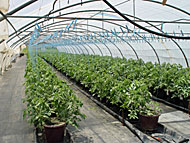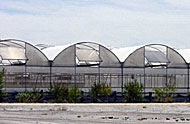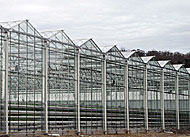
Types of greenhouses
Shape
Classification of a greenhouse is according to its basic shape. Types include Gable, Flat arch, Raised dome, Sawtooth, Skillion, Tunnel.
Multi-span structures
Multi-span greenhouses have a surface area smaller than a number of single span greenhouses of equivalent production capacity. This results in less heat loss and significant energy savings. Substantial economies of scale and production efficiencies are also attainable using multi-span designs.
Multi-spans are typically more robust in design. As a result they tend to suffer less damage during storms and gale force winds.
Other types of structures
Shade houses
Shade houses are structures which are covered in woven or otherwise constructed materials to allow sunlight, moisture and air to pass through the gaps. The covering material is used to provide a particular environmental modification, such as reduced light or protection from severe weather conditions. The height of the structure will vary according to the type of crop being produced and may be as high as 8 metres.
Shade houses are used over outdoor hydroponic systems, particularly in warmer regions.
Screen houses
Screen houses are structures which are covered in insect screening material instead of plastic or glass. They provide environmental modification and protection from severe weather conditions as well as exclusion of pests. They are often used to get some of the benefits of greenhouses in hot or tropical climates.
Crop top structures
A crop top is a structure with a roof but which does not have walls. The roof covering may be a greenhouse covering material such as plastic or glass, or shade cloth or insect screening. These structures provide some modification of the growing environment such as protection of the crop from rain or reduction of light levels.
Classifying greenhouses
Greenhouses are a technology based investment. The higher the level of technology used, the greater potential for achieving tightly controlled growing conditions. This capacity to tightly control the conditions in which the crop is grown is strongly related to the health and productivity of the crop. The following three categories of greenhouse have been defined to assist people in selecting the most appropriate investment for their needs and budget.
Low technology greenhouses

A significant proportion of the industry in Australia currently uses low technology structures. These greenhouses are less than 3 metres in total height. Tunnel houses, or "igloos", are the most common type. They do not have vertical walls. They have poor ventilation. This type of structure is relatively inexpensive and easy to erect. Little or no automation is used.
While this sort of structure provides basic advantages over field production, crop potential is still limited by the growing environment and crop management is relatively difficult. Low level greenhouses generally result in a suboptimal growing environment which restricts yields and does little to reduce the incidence of pests and diseases. Pest and disease control, as a result, is normally structured around a chemical spray program.
Low technology greenhouses have significant production and environmental limitations, but they offer a cost effective entry to the industry.
Medium technology greenhouses

Medium level greenhouses are typically characterised by vertical walls more than 2m but less than 4 metres tall and a total height usually less than 5.5 metres. They may have roof or side wall ventilation or both. Medium level greenhouses are usually clad with either single or double skin plastic film or glass and use varying degrees of automation.
Medium level greenhouses offer a compromise between cost and productivity and represent a reasonable economic and environmental basis for the industry. Production in medium level greenhouses can be more efficient than field production. Hydroponic systems increase the efficiency of water use. There is greater opportunity to use non-chemical pest and disease management strategies but overall the full potential of greenhouse horticulture is difficult to attain.
High technology greenhouses

High level greenhouses have a wall height of at least 4 metres, with the roof peak being up to 8 metres above ground level. These structures offer superior crop and environmental performance. High technology structures will have roof ventilation and may also have side wall vents. Cladding may be plastic film (single or double), polycarbonate sheeting or glass. Environmental controls are almost always automated. These structures offer enormous opportunities for economic and environmental sustainability. Use of pesticides can be significantly reduced. High technology structures provide a generally impressive sight and, internationally, are increasingly being involved in agribusiness opportunities.
Although these greenhouses are capital intensive, they offer a highly productive, environmentally sustainable opportunity for an advanced fresh produce industry. Investment decisions should, wherever possible, look to install high technology greenhouses.

